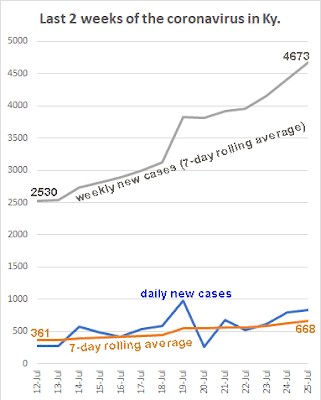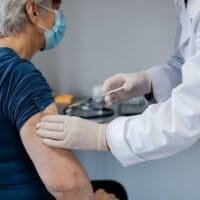As coronavirus cases in Kentucky surged into a red zone of the White House Coronavirus Task Force, Gov. Andy Beshear said again that he expects to take additional steps to curb its spread next week if the cases don’t stabilize — while reminding Kentuckians that it’s not too late to control it.

Beshear reported the second highest daily count of new cases, 836; the highest daily total, 979, was reported last Saturday. He also reported that 5.41% of Kentuckians who were tested for the virus last week tested positive, the highest rate reported in the last few months and a sign that the disease is spreading more actively, his news release said.
Beshear has said that the White House task force considers positive test rates above 5% to be in the “danger zone,” but he didn’t note another number that moved it into a red zone of the task force, which it uses as tripwires to suggest increased or restored limits on activities.
The state did that because Saturday’s 836 cases brought its seven-day total to 4,673. That took the seven-day average above the task force’s definition of a state in a red zone: one with more than 100 weekly cases per 100,000 population. That equals 1,000 cases per million; Kentucky’s estimated population is 4.468 million, so its “red zone” threshold is 4,468 cases per week.
Beshear said Friday that if the surge didn’t abate over the weekend, as he hopes it will due to the mask mandate he imposed two weeks ago, he will have to impose more restrictions. Two steps that the task force has recommended, but that he has not adopted, are closing bars and reducing restaurant capacity to 25 percent from 50 percent. He has said he would also consider other restrictions.
The state is faring better on the task force’s other red-zone metric: the seven-day average of positive coronavirus tests. If a state goes over 10 percent, it goes into the red zone. But Beshear noted that the state has broken the 5 percent “danger zone” threshold two days in a row, and suggested that Kentucky is becoming part of a national surge,
“Yesterday, there were more than 74,000 new cases and more than 1,000 deaths reported across the country,” Beshear said in a news release. “We know how to control this virus. We’ve seen states like New York — which had hospitals overflowing with sick patients in March and April — now reporting a positivity rate of 1 percent or less. If they can do it, we can do it. But we have to work together, stay smart and wear face coverings.”
Personal choices matter
Dr. Steven Stack, the state’s public health commissioner, said Kentucky can still avoid the crisis confronting other states, referring to those that are running out of intensive-care beds and seeing increasing deaths due to the virus.
“Our personal choices, right now and every day, will directly determine Kentucky’s situation in early August,” he said in the release. “Small acts of kindness and personal sacrifice will make a big difference. We can choose to delay a party or picnic. We can shop for groceries or go to the pharmacy when it’s less crowded. We can opt for an online or drive-up worship service. We can wear a face mask. Every one of us has a role to play in determining Team Kentucky’s future.”
The daily report shows 595 Kentuckians are hospitalized for COVID-19, 23 fewer than Friday, and 132 of them are in intensive care, about the same as Friday.
Beshear reported five new deaths, raising the state’s COVID-19 death toll to 696. The fatalities were a 79-year-old man from Casey County; an 80-year-old man from Christian County; a 66-year-old man from Ohio County; and two women, 68 and 93, from Fayette County.
“This is the part that never gets easier and never will,” said Beshear. “Every day that we do the right thing, we are protecting each other from the worst pain imaginable. My heart is with these families every waking moment.”
Counties with more than 10 new cases Saturday were Jefferson, 244; Warren, 54; Fayette, 49; Kenton, 36; Scott, 31; Daviess, 20; Hardin, 18; Christian, 17; Boone, 16; Jessamine and Oldham, 15 each; Barren 14 and Harlan, 14 each; Bullitt and Laurel, 12 each; Campbell and Franklin, 11 each.
(Editor’s note: An earlier version of this story had an incorrect number for the weekly average as of Friday.)
Melissa Patrick is a reporter for Kentucky Health News, an independent news service of the Institute for Rural Journalism and Community Issues, based in the School of Journalism and Media at the University of Kentucky, with support from the Foundation for a Healthy Kentucky. She has received several competitive fellowships, including the 2016-17 Nursing and Health Care Workforce Media Fellow of the Center for Health, Media & Policy, which allowed her to focus on and write about nursing workforce issues in Kentucky; and the year-long Association of Health Care Journalists 2017-18 Regional Health Journalism Program fellowship. She is a former registered nurse and holds degrees in journalism and community leadership and development from UK.






